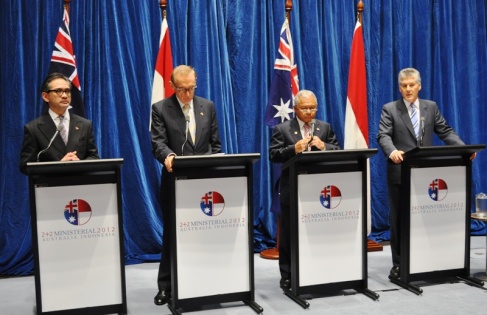This post originally appeared on the Lowy Institute’s blog The Interpreter and The Diplomat’s ASEAN Beat.
Just to be clear, Dr Mahathir Mohamad is not dead. In fact, the infamously direct style and strident anti-Westernism of the former Malaysian Prime Minister, lives on through current leader Najib Razak.

During his visit to Australia earlier this month, Najib’s rebuff of Prime Minister Gillard’s proposal for an offshore asylum-seeker processing centre in East Timor, showed hints of the former leader’s ambivalence towards Australia and its approach to the region.
During his 22 years at Malaysia’s helm, Mahathir made Australia his ‘whipping boy’. He rebuked Canberra for its colonial heritage and role as America’s deputy sheriff, stoking Malaysian pride and scoring strategic points in the process.
While the overall bilateral relationship was steady, in the background, Mahathir never shied away from publicly undermining Australian initiatives, often straining relations in the process. His notorious snubbing of the 1993 APEC summit, led then-PM Paul Keating to label him ‘recalcitrant’.
Two Malaysian leaders later, Najib invokes Mahathir’s tradition of public posturing in relation to Australia, albeit in a more muted tone. In response to questions about the East Timor processing centre, the Malaysian PM was lukewarm, at best. He explained that his country needed more time to consider the proposal and was firm that further discussion on the matter take place at the Bali summit on people smuggling, held this week.
In what could have been a proud moment celebrating Australian resourcefulness in promoting a regional solution, Australia found itself in the awkward situation of Malaysia basking in having called the shots.
In practical terms, Najib was right to ask for more time. For one, costs have not been provided. Also, it is now clear that Gillard did not circulate the idea before its announcement; the mixed reception from regional partners is telling in this regard. East Timor was briefed six months after Gillard launched the processing centre idea, in her Lowy Institute speech. This incident should give Australia a wake-up call to manage regional issues more carefully.
Moreover, Australia’s dithering on its processing centre plans, has allowed Malaysia to manoeuvre into a more favourable bargaining position. During his visit, Najib talked up Malaysia’s contribution to combating people smuggling via increased naval interdictions of SIEV suspected of heading to Australian shores.
He then proposed that Australia provide more resources to ‘front line countries like Malaysia’ to disrupt people smugglers. ‘Perhaps giving us more equipment, for example, more sophisticated equipment could help us increase our capacity’, Najib added. Add to the mix speculation of an election this year in Malaysia, and the effect is pronounced: Najib is scoring points using old tricks.
So, while the heydays of fiery Mahathir-Keating exchanges may be behind us, Malaysia’s recent capitalisation on Australia’s awkward decision-making on regional issues, suggests we haven’t seen the last of Mahathirism yet.
Photo courtesy of blog Mahathir Mohamed.
 The Republic of Singapore frigate RSS Formidable (68) during a formation exercise for RIMPAC 2012.
The Republic of Singapore frigate RSS Formidable (68) during a formation exercise for RIMPAC 2012.

